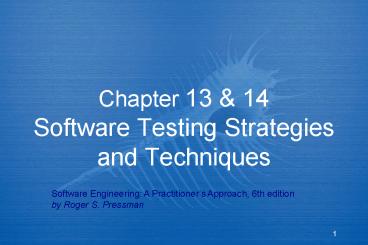Chapter 13 - PowerPoint PPT Presentation
1 / 31
Title:
Chapter 13
Description:
Unit Test Environment. Module. stub. stub. driver. RESULTS. interface. local data structures ... Sample Equivalence Classes. user supplied commands. responses ... – PowerPoint PPT presentation
Number of Views:20
Avg rating:3.0/5.0
Title: Chapter 13
1
Chapter 13 14Software Testing Strategiesand
Techniques
Software Engineering A Practitioners Approach,
6th edition by Roger S. Pressman
2
Software Testing
Testing is the process of exercising a program
with the specific intent of finding errors prior
to delivery to the end user.
3
What Testing Shows
errors
requirements conformance
performance
an indication of quality
4
Who Tests the Software?
developer
independent tester
Understands the system
Must learn about the system,
but, will test "gently"
but, will attempt to break it
and, is driven by quality
and, is driven by "delivery"
5
Validation vs Verification
- Verification Are we building the product right?
- Is the code correct with respect to its
specification? - Validation Are we building the right product?
- Does the specification reflect what it should?
6
Testing Strategy
unit test
integration test
system test
validation test
7
Testing Strategy
- Begin with unit testing and work your way up to
system testing. - Unit testing test individual components
(modules in procedural languages classes in OO
languages) - Integration testing test collections of
components that must work together - Validation testing test the application as a
whole against user requirements - System testing test the application in the
context of an entire system
8
Unit Testing
module to be tested
results
software engineer
test cases
9
Unit Testing
module to be tested
interface
local data structures
boundary conditions
independent paths
error handling paths
test cases
10
Unit Test Environment
driver
interface
local data structures
Module
boundary conditions
independent paths
error handling paths
stub
stub
test cases
RESULTS
11
Integration Testing Strategies
Options the big bang approach an
incremental construction strategy
12
Top Down Integration
A
top module is tested with
stubs
B
F
G
stubs are replaced one at
a time, "depth first"
C
as new modules are integrated,
some subset of tests is re-run
D
E
13
Bottom-Up Integration
A
B
F
G
drivers are replaced one at a
time, "depth first"
C
worker modules are grouped into
builds and integrated
D
E
cluster
14
Regression Testing
- The selective retesting of a modified system to
help ensure that no bugs have been introduced
during modification. - Fixing one part of the code can break another
15
High Order Testing
- Validation testing
- Focus is on software requirements
- System testing
- Focus is on system integration
- Alpha/Beta testing
- Focus is on customer usage
- Recovery testing
- forces the software to fail in a variety of ways
and verifies that recovery is properly performed - Security testing
- verifies that protection mechanisms built into a
system will, in fact, protect it from improper
penetration - Stress testing
- executes a system in a manner that demands
resources in abnormal quantity, frequency, or
volume - Performance Testing
- test the run-time performance of software within
the context of an integrated system
16
What is a Good Test?
- A good test is one that has a high probability of
finding an error.
17
Test Case Design
"Bugs lurk in corners
and congregate at
boundaries ..."
Boris Beizer
OBJECTIVE
to uncover errors
CRITERIA
in a complete manner
CONSTRAINT
with a minimum of effort and time
18
Exhaustive Testing
loop lt 20 X
14
There are 10 possible paths! If we execute one
test per millisecond, it would take 3,170 years
to
test this program!!
19
Selective Testing
Selected path
loop lt 20 X
20
Software Testing
black-box methods
white-box methods
Methods
Strategies
21
White-Box Testing
... our goal is to ensure that all
statements and conditions have
been executed at least once ...
22
Why Cover?
logic errors and incorrect assumptions
are inversely proportional to a path's
execution probability
we often
believe
that a path is not
likely to be executed in fact, reality is
often counter intuitive
typographical errors are random it's
likely that untested paths will contain
some
23
Basis Path Testing
First, we compute the cyclomatic
complexity
number of simple decisions 1
or
number of enclosed areas 1
In this case, V(G) 4
24
Cyclomatic Complexity
A number of industry studies have indicated
that the higher V(G), the higher the probability
or errors.
modules
V(G)
modules in this range are
more error prone
25
Basis Path Testing
Next, we derive the
independent paths
Since V(G) 4,
there are four paths
Path 1 1,2,3,6,7,8
Path 2 1,2,3,5,7,8
Path 3 1,2,4,7,8
Path 4 1,2,4,7,2,4,...7,8
Finally, we derive test
cases to exercise these
paths.
26
Basis Path Testing Notes
27
Black-Box Testing
requirements
output
input
events
28
Equivalence Partitioning
user queries
FK input
output formats
mouse picks
data
prompts
29
Sample Equivalence Classes
Valid data
user supplied commands
responses to system prompts
file names
computational data
physical parameters
bounding values
initiation values
output data formatting
responses to error messages
graphical data (e.g., mouse picks)
Invalid data
data outside bounds of the program
physically impossible data
proper value supplied in wrong place
30
Boundary Value Analysis
user queries
FK input
output formats
mouse picks
data
prompts
output domain
input domain
31
OOT Methods Behavior Testing
The tests to be designed should achieve all state
coverage KIR94. That is, the operation
sequences should cause the Account class to make
transition through all allowable states































